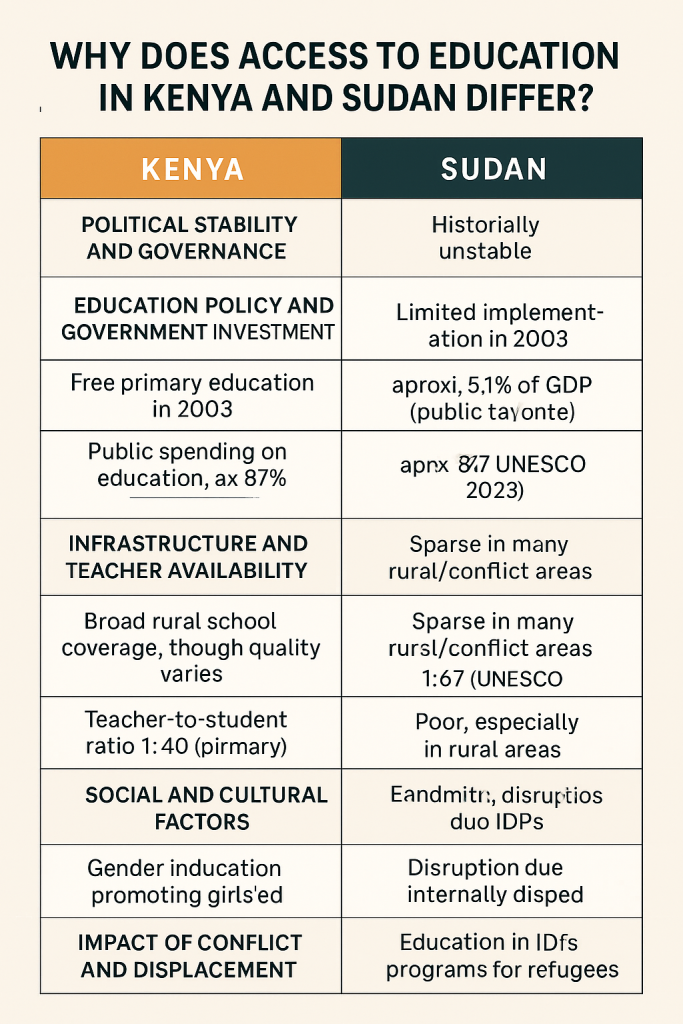Why Does Access to Education in Kenya and Sudan Differ?
Access to education is a fundamental human right and a cornerstone for national development. However, in many African countries, this right is unevenly realized. Kenya and Sudan offer a revealing comparison: though both are located in East Africa and share similar colonial histories, their educational systems differ significantly in terms of access to education in Kenya and Sudan, as well as quality, and outcomes. This article explores the key reasons behind these differences and provides a comparative analysis of the two countries’ education systems.

1. Political Stability and Governance
| Factor | Kenya | Sudan |
|---|---|---|
| Political Stability | Relatively stable | Historically unstable |
| Impact on Education | Steady investment and reform | Interrupted schooling due to conflict |
Kenya has enjoyed relatively stable governance since its independence in 1963. This stability has allowed the government to invest consistently in education reforms. In contrast, Sudan has experienced decades of civil war, coups, and conflict, which have severely disrupted schooling and infrastructure, especially in conflict-prone areas like Darfur and the southern regions (before South Sudan’s secession in 2011).
According to UNESCO (2023), political instability is one of the primary factors limiting educational access in Sudan, especially for girls and children in rural areas.
2. Education Policy and Government Investment
| Indicator | Kenya | Sudan |
|---|---|---|
| Free Primary Education | Introduced in 2003 | Limited implementation |
| Public Spending on Education | ~5.1% of GDP (World Bank, 2022) | ~2.2% of GDP (World Bank, 2022) |
| Literacy Rate (Youth, 15-24) | ~87% (UNICEF, 2023) | ~61% (UNICEF, 2023) |
Kenya introduced Free Primary Education (FPE) in 2003, dramatically increasing enrollment. The government followed with free day secondary education in 2008. These reforms, supported by international donors such as UNESCO and the World Bank, have expanded access, particularly among the poor.
Sudan, on the other hand, has not consistently implemented FPE. The nation’s lower investment in education reflects broader fiscal challenges and priorities focused on security and political control rather than social development.
3. Infrastructure and Teacher Availability
| Category | Kenya | Sudan |
|---|---|---|
| Rural School Coverage | Broad, though quality varies | Sparse in many rural/conflict areas |
| Teacher-to-Student Ratio | 1:40 (primary level) | 1:67 (UNESCO, 2023) |
| School Facilities | Mixed, but better resourced overall | Poor, especially in rural areas |
Kenya has a better developed school infrastructure network, though challenges remain in remote areas like Turkana. Schools are more likely to have permanent buildings, textbooks, and access to trained teachers.
In Sudan, a lack of trained teachers and damaged or absent infrastructure limits education access. Many students study under trees or in temporary shelters, especially in displaced communities.
4. Social and Cultural Factors
Gender and Education
Kenya has made significant strides in promoting girls’ education, especially with policies like sanitary towel distribution and girl-friendly school environments. Organizations like Plan International and FAWE Kenya have also played a strong role.
In Sudan, early marriage, cultural norms, and gender inequality remain major barriers for girls. According to Human Rights Watch (2021), in rural Sudan, only about 35% of girls complete primary education.
Language of Instruction
In Kenya, English and Kiswahili are widely used in education, aiding national cohesion. In Sudan, Arabic dominates, but many ethnic groups speak different mother tongues. This language mismatch can discourage school attendance and learning among minority children.
5. Impact of Conflict and Displacement
Sudan has one of the largest populations of internally displaced people (IDPs) in Africa, especially due to ongoing violence in Darfur and recent conflict in Khartoum. Displacement disrupts children’s access to schooling and leads to a loss of educational continuity.
Kenya, while hosting refugees (e.g., in Dadaab and Kakuma), has a comparatively lower rate of internally displaced children and has implemented Education in Emergencies (EiE) programs to integrate refugee children into schools.
Access to education in Kenya and Sudan differs significantly due to a combination of political, economic, infrastructural, and cultural factors. Kenya’s relatively stable governance, stronger investment in education, and inclusive policies have improved educational access. In contrast, Sudan’s ongoing conflicts, underfunding, and societal barriers continue to impede progress.
Improving education in Sudan will require peacebuilding, increased investment, teacher training, and targeted programs to reach marginalized groups—especially girls. Kenya, while ahead, must continue addressing quality gaps and ensuring rural and underserved communities are not left behind.
7.References
UNESCO Institute for Statistics (UIS), 2023: http://uis.unesco.org
World Bank Education Statistics, 2022: https://databank.worldbank.org
UNICEF Kenya and Sudan Country Profiles, 2023
Human Rights Watch. “Education Denied: Barriers for Girls in Sudan,” 2021.
Plan International Reports on Education in East Africa (2023)



